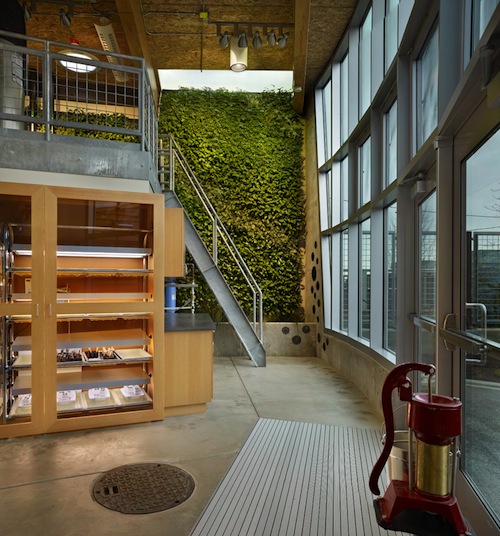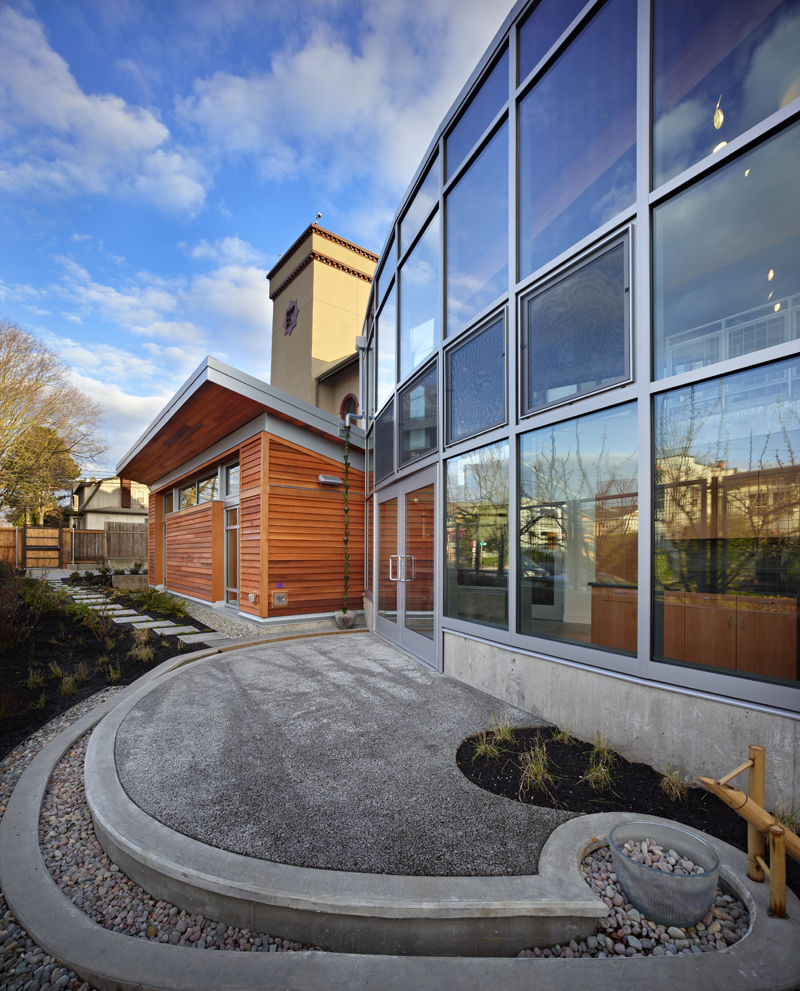SEATTLE, WASH.—April 15, 2013— Bertschi School, an independent elementary school in the Capitol Hill neighborhood of Seattle, Wash., is now home to the first Living Building on the West Coast and the world’s fourth fully-certified Living Building. Completed in February 2011, Bertschi’s Living Building Science Wing is a 3,380 square foot interactive learning environment for students ages 5-11. It is the first built project to meet the standards of version 2.0 of the Living Building ChallengeSM, a green building certification program which integrates urban agriculture, social justice and universal access issues, and the use of healthy building materials.
A program of the International Living Future Institute, the Living Building Challenge(LBC) is widely considered the world’s most rigorous building performance standard. A Living Building generates all of its own energy through clean, renewable resources; captures and treats its own water; incorporates only non-toxic, appropriately sourced materials; and operates efficiently and for maximum beauty. A building must perform as designed for one full year of occupancy and pass a third-party audit before receiving certification as “Living.”
Conceptualized with significant teacher and student input, the Science Wing serves as the ultimate tool for teaching science and sustainability. Students participate in real-time monitoring of the building’s energy and water use to understand sustainable practices and witness the impact of their daily choices on the building’s performance.
"At Bertschi School, we are committed to educating children to become thoughtful stewards of their local and global communities,” said Brigitte Bertschi, Head of Bertschi School. “We are not simply teaching about how to responsibly manage resources. The Science Wing allows students to put our curriculum to authentic use. I am proud that our children are empowered to make a difference at a very young age — even if it is a small one."
Bertschi School’s Science Wing sits on an urban site with an ethnobotanical garden that serves as an outdoor classroom. With its indigenous northwest plants, the garden enables students to learn about native culture and history, as well as use plant material in their art classes, such as berries for paint dyes and grasses used to fashion paint brushes. Food produced in this garden — and in the neighboring vegetable garden on-site — helps educate students about the values of organic farming and growing food.
The building’s sustainable features are visible and functional to foster dynamic learning opportunities. It is net-zero energy and water; a 20 kilowatt photovoltaic system provides all of the electricity, and cisterns collect rainwater that is used for irrigation and flushing the composting toilet. Excess captured water is absorbed by the on-site rain garden. Other water-saving features include a green roof and an interior living wall of tropical plants, which treats all of the building’s grey water.
The design of the Science Wing derived from a partnership between Bertschi School and the Restorative Design Collective, a multi-disciplinary team led by KMD Architects and comprised of leading Pacific Northwest green building professionals. The Collective contributed their design services pro-bono, with donations amounting to more than $500,000 in professional time and building materials.
“The challenges in creating truly net-zero energy and water buildings help all of us understand the integrative and continual efforts that are necessary to achieve the high-performance buildings that our changing planet requires,” said Stacy Smedley of KMD Architects, co-founder of the Restorative Design Collective.
In order to meet LBC standards, Skanska USA’s green building team navigated the strict material requirements to source building products that did not contain any of the materials or chemicals on the LBC Red List. One of the greatest challenges in this effort was finding local manufacturers and vendors who were fully transparent about the chemical makeup of their products. The use of healthy materials promotes better indoor air quality, as well as furthers transparency in the building materials industry.
“The Living Building Challenge is creating a major shift in the built environment — just as LEED did 10 years ago,” said Chris Toher, executive vice president and general manager at Skanska USA Building. “Thanks to the Restorative Design Collective, the Bertschi Living Building Science Wing is a model for sustainability in construction, and has challenged our industry to push for more net-zero buildings in our region and beyond.”
"The Bertschi School Science Wing has met the highest standard for sustainable performance, and is a powerful model for school additions all over the globe,” said Jason F. McLennan, CEO of the International Living Future Institute. “The International Living Future Institute is extremely proud of the huge accomplishments of this wonderful academic project."
Bertschi School is located at 2227 10th Ave. East in Seattle. Tours of the Living Science Building will be available to attendees of this year’s Living Future unConference, the International Living Future Institute’s 7th annual green building summit taking place May 15-17 at the Westin Seattle. Additional tours will be offered by the school throughout the year. More information is available in the International Living Future Institute’s Living Building case study.
About Bertschi School
An independent elementary school known for its integrated, innovative program, Bertschi School has a strong commitment to sustainability and incorporates this focus into both its curriculum and operations. In 2007, the school completed construction on its main building, The Bertschi Center, which is the first LEED Gold certified elementary classroom building in Washington State. www.bertschi.org
About the Restorative Design Collective
The Restorative Design Collective was founded in 2009 by Stacy Smedley and Chris Hellstern of KMD Architects. The Collective recognizes and endeavors to further the Living Building Challenge, which plays an essential role in raising green building standards, meeting the 2030 Challenge and creating net-zero buildings. Members of the Collective and its collaborators include: GGLO, landscape architect; 2020 Engineering, civil engineer; Back to Nature Design LLC, food systems consultant; GeoEngineers, geotechnical engineer; Morrison Hershfield, envelope consultant; O’Brien and Company, sustainable design consultant; Quantum Consulting Engineers, structural engineer; Rushing, mechanical-electrical-plumbing engineer; Skanska USA Building, general contractor; and Parsons Public Relations, as well as the City of Seattle and King County. KMD’s strong commitment to research-based design and collaboration fostered the opportunity to bring together a group of Seattle-area design professionals who share the desire to push themselves and their firms to the forefront of the sustainable building movement and create a built case study of a Living Building.
About the International Living Future InstituteSM and the Living Building ChallengeSM
The International Living Future Institute is an environmental NGO committed to catalyzing the transformation toward communities that are socially just, culturally rich and ecologically restorative. The Institute is premised on the belief that providing a compelling vision for the future is a fundamental requirement for reconciling humanity’s relationship with the natural world. The Institute operates the Living Building Challenge, the built environment’s most rigorous performance standard, and Declare, an ingredients label for building materials. It also houses the Cascadia Green Building Council and Ecotone Publishing.
The Living Building Challenge, the Institute’s best-known program, calls for the creation of a built environment that is as elegant and efficient as nature’s architecture. To be certified under the Challenge, a project must demonstrate that it has achieved 20 rigorous imperatives including net-zero energy, waste and water and alignment with a Red List of worst-in-class materials. The Challenge is the 2012 winner of the Buckminster Fuller Prize.
Related Stories
Codes and Standards | Mar 15, 2024
Technical brief addresses the impact of construction-generated moisture on commercial roofing systems
A new technical brief from SPRI, the trade association representing the manufacturers of single-ply roofing systems and related component materials, addresses construction-generated moisture and its impact on commercial roofing systems.
Sports and Recreational Facilities | Mar 14, 2024
First-of-its-kind sports and rehabilitation clinic combines training gym and healing spa
Parker Performance Institute in Frisco, Texas, is billed as a first-of-its-kind sports and rehabilitation clinic where students, specialized clinicians, and chiropractic professionals apply neuroscience to physical rehabilitation.
Market Data | Mar 14, 2024
Download BD+C's March 2024 Market Intelligence Report
U.S. construction spending on buildings-related work rose 1.4% in January, but project teams continue to face headwinds related to inflation, interest rates, and supply chain issues, according to Building Design+Construction's March 2024 Market Intelligence Report (free PDF download).
Apartments | Mar 13, 2024
A landscaped canyon runs through this luxury apartment development in Denver
Set to open in April, One River North is a 16-story, 187-unit luxury apartment building with private, open-air terraces located in Denver’s RiNo arts district. Biophilic design plays a central role throughout the building, allowing residents to connect with nature and providing a distinctive living experience.
Sustainability | Mar 13, 2024
Trends to watch shaping the future of ESG
Gensler’s Climate Action & Sustainability Services Leaders Anthony Brower, Juliette Morgan, and Kirsten Ritchie discuss trends shaping the future of environmental, social, and governance (ESG).
Affordable Housing | Mar 12, 2024
An all-electric affordable housing project in Southern California offers 48 apartments plus community spaces
In Santa Monica, Calif., Brunson Terrace is an all-electric, 100% affordable housing project that’s over eight times more energy efficient than similar buildings, according to architect Brooks + Scarpa. Located across the street from Santa Monica College, the net zero building has been certified LEED Platinum.
Museums | Mar 11, 2024
Nebraska’s Joslyn Art Museum to reopen this summer with new Snøhetta-designed pavilion
In Omaha, Neb., the Joslyn Art Museum, which displays art from ancient times to the present, has announced it will reopen on September 10, following the completion of its new 42,000-sf Rhonda & Howard Hawks Pavilion. Designed in collaboration with Snøhetta and Alley Poyner Macchietto Architecture, the Hawks Pavilion is part of a museum overhaul that will expand the gallery space by more than 40%.
Affordable Housing | Mar 11, 2024
Los Angeles’s streamlined approval policies leading to boom in affordable housing plans
Since December 2022, Los Angeles’s planning department has received plans for more than 13,770 affordable units. The number of units put in the approval pipeline in roughly one year is just below the total number of affordable units approved in Los Angeles in 2020, 2021, and 2022 combined.
BIM and Information Technology | Mar 11, 2024
BIM at LOD400: Why Level of Development 400 matters for design and virtual construction
As construction projects grow more complex, producing a building information model at Level of Development 400 (LOD400) can accelerate schedules, increase savings, and reduce risk, writes Stephen E. Blumenbaum, PE, SE, Walter P Moore's Director of Construction Engineering.
AEC Tech | Mar 9, 2024
9 steps for implementing digital transformation in your AEC business
Regardless of a businesses size and type, digital solutions like workflow automation software, AI-based analytics, and integrations can significantly enhance efficiency, productivity, and competitiveness.



















